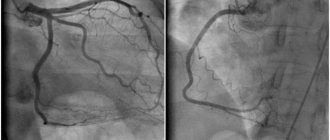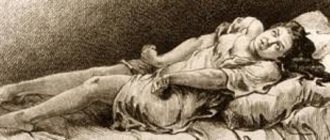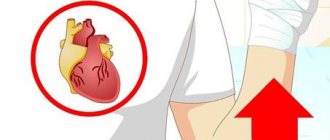Classification
One of the types of circulatory disorders in the human body is called acute heart failure.
The normal functioning of all organs is impossible without a sufficient amount of incoming blood, and with it oxygen. When there is a circulatory disorder, a serious disruption occurs in the body. Acute heart failure is dangerous because it appears suddenly. It may be a consequence of any other diseases or organ dysfunctions. Lifestyle also plays a big role. Smoking and drinking alcoholic beverages have a negative impact on the functioning of the body. As a result of these bad habits, the blood thickens, which leads to blockage of blood vessels and stops the entire circulatory system.
Important. If qualified medical care is not provided in a timely manner, a person can die in a matter of hours.
The danger of the disease is that it can manifest itself against the background of chronic heart failure.
The disease has certain varieties, the diagnosis of which is impossible without a medical examination.
Types of disease by localization:
- left ventricular;
- right ventricular;
- mixed.
The first type manifests itself when the left ventricle is overloaded or as a result of destabilization of the contractile function of the myocardium. Narrowing of the aortas and myocardial infarction occur, leading to a sharp decrease in the amount of blood in the systemic circulation.
Right ventricular pathology is characterized by stagnation of blood in the systemic circulation. Appears as a result of overload of the right ventricle. The patient experiences swelling of the internal organs (often the lungs), discoloration of the skin, and general exhaustion of the body.
The mixed type of disease, characterized by destabilization of the right and left stomachs, is considered the most dangerous type - blood circulation in the body is completely disrupted.
There is also a classification of the disease, which is determined by the hypokinetic type of hemodynamics. It includes reflex shock (pain syndrome in the heart area, which is eliminated with the help of analgesic therapy); arrhythmic shock (appears as a result of heartbeat disturbances); cardiogenic shock (diagnosed in people over 60 years of age, damage to the heart muscle exceeds by 40-50% the total mass of the myocardium of the left stomach).
A condition in the body in which the heart is unable to supply the organs with a normal amount of blood is called acute deterioration of chronic acute heart failure.
Types of disease
According to the distribution of the pathological process, the following types of cardiovascular failure are distinguished:
- Regional – occurs when there is a circulatory disorder in the peripheral vessels.
- Systemic – appears when there is a disturbance in the general blood flow.
Based on the rate of increase in symptoms, the pathology can be acute or chronic. In the first case, its symptoms appear rapidly due to a sharp drop in pressure. The chronic type of condition takes a long time to develop, and its “provoker” is usually a persistent decrease in blood pressure less than 100/60. Chronic failure can be primary (caused by disorders of the autonomic system) and secondary (due to various diseases).
Signs of illness
Timely provision of assistance can save the patient's life. It is for this reason that it is necessary to know the main signs of the disease.
These include shortness of breath, general weakness and rapid fatigue of a person even with light loads. Confusion, thread-like pulse, drowsiness, fluctuations in blood pressure, and swelling of the lower extremities are also observed.
Signs of left ventricular acute heart failure:
- wet cough with foamy sputum;
- wheezing in the bronchi and lungs;
- dyspnea;
- attacks of suffocation at night;
- pain behind the sternum, transmitted under the shoulder blade;
- constant dizziness.
The patient is in a position that is comfortable for him almost all the time - a sitting position. Fainting is quite common. During the course of the disease, cardiogenic shock, pulmonary edema and cardiac asthma develop.
Signs of right ventricular pathology:
- discomfort in the sternum area;
- dyspnea;
- dizziness;
- increased heart rate;
- swelling of the limbs;
- pale skin;
- swelling of the veins located in the neck;
- weakness;
- ascites;
- acrocyanosis;
- hyperhidrosis;
- gelatomegaly.
The disease is characterized by stagnation of blood in the systemic circulation.
In the early stages of the disease, symptoms will be minor. Shortness of breath may occur during physical activity. The patient often ignores it due to age-related changes in the body. A cough appears due to increased pressure in the blood vessels of the lungs. There is a rapid heartbeat after exercise or eating. The patient complains of fatigue and general weakness.
Quite often the patient's urine output decreases. This is due to impaired blood circulation in the pelvis. Swelling appears in the lower extremities. The tip of the nose, as well as the skin of the feet and hands, acquire a bluish tint.
Important. If blood stagnation occurs in the liver vessels, acute heart failure is accompanied by pain syndromes under the right rib.
As the disease progresses, blood circulation in the brain becomes impaired. The main symptoms at this stage are irritability, fatigue after mental stress, and a constant state of depression. There is sleep disturbance. If measures are not taken in a timely manner, the pathology will lead to death.
Acute heart failure and its symptoms before death:
- unbearable pain in the heart area and under the shoulder blade;
- drowsiness;
- general weakness of the body;
- noisy breathing, which then slows down and becomes convulsive;
- dilated pupils;
- change in skin tone (pallor);
- the pulse in the carotid arteries cannot be felt;
- absence of pupillary and corneal reflexes;
- pre-fainting state.
Important. If you observe all these symptoms, you should immediately call an ambulance.
A person can die in a matter of minutes. As a rule, deaths are observed outside hospital settings. Death can occur as a result of nervous shock or significant physical exertion. Cases of lethality at rest are not uncommon. It all depends on the stage of development of the disease.
Symptoms of vascular insufficiency
Characteristic manifestations of acute vascular insufficiency are shock, fainting or collapse. The difference between them consists mainly in the absence or presence of a disorder of consciousness, however, each condition also has its own characteristic symptoms:
- Fainting is characterized by the suddenness of its appearance, a sharp deterioration in general health, and autonomic disorders. Usually a person feels increasing weakness, discomfort, nausea, and then loses consciousness for a while. As the pathological condition develops, pale skin, ringing sounds in the ears, and a feeling as if the earth is disappearing from under one’s feet are observed.
- Collapse is associated with a decrease in the volume of circulating blood and a deterioration in vascular tone. Symptoms of vascular insufficiency in such a situation manifest themselves in the form of weakened vision and a feeling of thirst. The person remains conscious, but his skin turns pale, his face takes on a sallow color, and his fingers, lips and the tip of his nose become bluish. The pathology is characterized by indifference to everything around, a feeling of melancholy and shallow breathing.
- Shock is a complex pathological process caused by a sharp decrease in blood flow against the background of extreme influences (electric shock, burns, severe injuries, etc.). The clinical picture of shock is almost similar to collapse, but it goes through several stages, and at the last (terminal) the actions of doctors may not produce results.
Causes
The heart is the main connecting link in the blood circulation chain. Disturbances in its work will cause destabilization in the functioning of all organs.
The main causes of acute heart failure:
- heart disease (acute myocardial infarction, myocarditis);
- pathologies of the development and functioning of the heart chambers and its valves;
- myocardial hypertrophy;
- decompensation of chronic deficiency;
- hypertensive crisis;
- cardiac tamponade - stagnation of fluid between the layers of the pericardial sac;
- pulmonary embolism - the formation of blood clots, which most often block the veins in the pelvis and lower extremities;
- acute diseases of the lungs and bronchi.
These causes of acute heart failure are observed due to disruptions in the functioning of the main organ. Insufficient blood flows to the vessels.
There are several other reasons for the development of the disease that are not related to the functioning of the heart muscle. These include: extensive surgical intervention in the human body (restoration of internal organs after damage), respiratory infections, brain injuries, nervous shock, excessive use of antidepressants, bronchial asthma, stroke, toxic effects on the myocardium.
The latter is extremely dangerous for the entire body. It appears as a result of excessive consumption of alcoholic beverages, as well as smoking.
Traditional treatment
With timely diagnosis, the patient's life can be saved. Treatment of acute heart failure requires an integrated approach. The main actions are aimed at reducing the symptoms of the disease.
Important. Patients who have been diagnosed with acute heart failure, and the causes of its occurrence have been identified, require immediate hospitalization.
The patient is prescribed vasodilators to reduce pressure in the venous vessels. This type of medication will help reduce the amount of blood flowing to the heart. This effect suppresses the systolic load on the myocardium.
With the help of special medications, foamy sputum and progressive shortness of breath are eliminated. Pulmonary edema and cardiogenic shock are neutralized.
If blood stagnation occurs in the small circulation, it is necessary to perform bloodletting. This will help suppress the risk of swelling in a person's lungs and airways. As a result of proper treatment, blood flow in the venous vessels decreases.
Note. Bloodletting is done in a volume of no more than 500 ml. For anemia and low blood pressure, this method of treatment is contraindicated.
In severe cases of the disease, leeches are additionally used. They are installed on the sacral area. When the attack is localized in the right stomach, leeches are placed in the liver area. If cardiac asthma is observed, bloodletting is performed using a radical method.
Quite often they try to treat the patient using alternative medicine methods or folk remedies. Self-medication can lead to negative consequences, as well as death.
Diagnostics
To establish a diagnosis of AHF, you need an examination by a cardiologist with an assessment of complaints, objective examination data, measurement of blood pressure, pulse, listening to the heart and lungs, and palpation. To select the correct treatment, the doctor needs to identify the causative factors of the pathology, its type and severity. For these purposes the following are prescribed:
- ECG in 12 leads. An electrocardiogram must be performed as quickly as possible to determine rhythm disturbances, conduction disturbances and exclude a heart attack.
- Determination of blood saturation (oxygen saturation) using a pulse oximeter.
- Chest X-ray. In some cases, it confirms venous congestion in the lungs and edema, pleural effusion, pneumonia.
- Echo-KG. This is an ultrasound of the heart, which makes it possible to clarify the size of the heart chambers, the thickness of the myocardium, the condition of the valves, as well as determine myocardial contractility and cardiac ejection fraction.
- Holter monitoring is a daily continuous recording of an ECG using a special device to detect dangerous rhythm disturbances.
- Coronary angiography, computed tomography, MRI, transesophageal echocardiography are additional instrumental studies that are prescribed before cardiac surgery.
- Laboratory diagnostic methods.
Laboratory diagnostic methods most often determine:
- general blood characteristics - platelets, leukocytes, erythrocytes, hemoglobin and blood sugar levels, microelements (potassium, sodium and magnesium), biochemical metabolic parameters (urea, creatinine, bilirubin and transaminases);
- blood clotting indicators, including D-dimer and INR, which characterize the risks of thrombosis and the adequacy of therapy with anticoagulants;
- specific markers of damage to the heart muscle: level of troponins T and I, creatine phosphokinase (CPK-MB fraction);
- the level of specific natriuretic peptides to confirm the diagnosis of HF (acute and chronic, systolic and diastolic);
- blood gas composition (oxygen, carbon dioxide).
Features of pathology in children
Acute heart failure is a disease that occurs not only in adults, but also in children. This disease can be diagnosed in a timely manner by taking certain tests and undergoing an ultrasound.
Acute heart failure in children can be left ventricular, right ventricular and total. The disease occurs as a complication after infections, in the presence of allergic diseases, as a result of exogenous poisoning. Quite often observed in children who are born with heart defects. A feature of the disease is its rapid course.
There are three stages of disease development:
- At the first stage, shortness of breath, tachycardia, muffled heart sounds, wet and dry rales are observed, and the minute volume of blood decreases.
- The second is characterized by the presence of signs of pulmonary edema, enlarged liver, the appearance of wheezing when breathing, and puffiness of the face is observed.
- At the third stage, pulmonary edema, fluctuations in blood pressure and oligoanuria are diagnosed.
The disease can be triggered by an abnormal heart rhythm as a result of excessive activity. Myocardial integrity also plays an important role. When it is damaged, blood does not reach all organs in a timely manner.
Prevention of vascular insufficiency
Preventive measures to prevent vascular insufficiency consist of preventing diseases that can cause the pathological condition. It is necessary to adhere to a healthy diet, control blood pressure, and if you have hypertension, take medications prescribed by your doctor. It is advisable to give up bad habits and foods rich in cholesterol. Regular walks and exercise are recommended.
If symptoms of heart or vascular diseases appear, you should immediately contact a specialist to diagnose and treat them. The Euromedprestige clinic is ready to conduct a comprehensive examination and help you avoid the development of pathology.
Forecast
The syndrome and type of acute heart failure can only be diagnosed as a result of a proper medical examination. The prognosis for patients cannot be called negative. According to statistics, the mortality rate of patients within 60 days after the onset of the disease is 10%. For re-hospitalization – 35%. The first year of the disease is characterized by a mortality rate of 40%.
Almost every second patient diagnosed with the disease requires readmission to the hospital.
To save the patient, it is necessary to undergo a qualified medical examination. Based on the results of the tests, the doctor makes a diagnosis and prescribes treatment. It is not recommended to ignore the first signs of acute heart failure. The disease develops quite quickly, and sometimes it is impossible to save a person’s life.
conclusions
Not all diseases that lead to the development of cardiopulmonary failure are reversible, but the right treatment can reduce symptoms to a minimum. Lifestyle changes such as regular physical activity, healthy eating, reducing dietary salt, reducing stress and excess weight improve prognosis and quality of life.
The only way to prevent the development of SLN is to control the underlying disease and follow the instructions of the attending physician.











